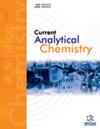用于片剂中盐酸地尔硫卓测定的高效、经济的改性碳浆电极
IF 1.7
4区 化学
Q3 CHEMISTRY, ANALYTICAL
引用次数: 0
摘要
背景与目的:本研究提出了用不同离子对修饰的新型灵敏、选择性改性碳浆(MCPE)电位传感器,用于测定生物液体、药物制剂及其纯品中的抗高血压药物盐酸地尔硫卓(DTM-HCl)。方法:增塑剂、离子对类型评估发现,增塑剂、离子对类型、离子对含量、响应时间、温度和 pH 值只是影响电极效率的几个实验因素。通过混合地尔硫卓-四苯基硼酸酯(DTM-TPB)离子对、石墨和作为增塑剂的 TCP 或 o-NPOE 制备了两个灵敏度最高的电极。结果在 1.0x10-5-1.0x10-2 的浓度范围内,所制得的电极 I 和 II 的单价 Nernstian 反应分别为 55.7±0.902 和 57.6±0.451 mV 十年-1。利用所建议电极的选择性特性研究了干扰离子。使用这些改良电极测量了药物制剂和生物液体中 DTM-HCl 的浓度。在验证过程中,使用了线性、准确度、精密度、检测限、定量限和特异性等指标。结论从 F 值和 t 检验值可以看出,所获得的结果与 HPLC 技术具有良好的一致性。本文章由计算机程序翻译,如有差异,请以英文原文为准。
An Efficient and Cost-effective Modified Carbon Paste Electrodes for Diltiazem Hydrochloride Determination in Tablets
Background and Objective: This study presented new sensitive and selective modified carbon paste (MCPE) potentiometric sensors modified with different ion pairs for the determination of the antihypertensive drug diltiazem hydrochloride (DTM-HCl) in biological fluids, pharmaceutical preparations, and in its pure form. Methods: Plasticizers, ion pair type, ion pair content, response time, temperature, and pH were just a few of the experimental factors evaluated that were found to affect electrode efficiency. The two electrodes that show the best sensitivity were prepared by mixing diltiazem-tetraphenyl borate (DTM-TPB) ion pair, graphite, and TCP or o-NPOE as a plasticizer. Result: Over the concentration ranges of 1.0x10-5–1.0x10-2, the produced electrodes I and II demonstrated monovalent Nernstian responses of 55.7±0.902 and 57.6±0.451 mV decade-1. The selectivity property of the suggested electrodes was used to study the interference ions. The concentration of DTM-HCl in pharmaceutical formulations and biological fluids was measured using these modified electrodes. During the validation procedure, metrics like linearity, accuracy, precision, limit of detection, limit of quantification, and specificity were used. Conclusion: The obtained results showed good agreement with the HPLC technique as indicated by the F and t-test values and can conclude the possibility of using this potentiometric method in the routine analysis of DTM-HCl.
求助全文
通过发布文献求助,成功后即可免费获取论文全文。
去求助
来源期刊

Current Analytical Chemistry
化学-分析化学
CiteScore
4.10
自引率
0.00%
发文量
90
审稿时长
9 months
期刊介绍:
Current Analytical Chemistry publishes full-length/mini reviews and original research articles on the most recent advances in analytical chemistry. All aspects of the field are represented, including analytical methodology, techniques, and instrumentation in both fundamental and applied research topics of interest to the broad readership of the journal. Current Analytical Chemistry strives to serve as an authoritative source of information in analytical chemistry and in related applications such as biochemical analysis, pharmaceutical research, quantitative biological imaging, novel sensors, and nanotechnology.
 求助内容:
求助内容: 应助结果提醒方式:
应助结果提醒方式:


